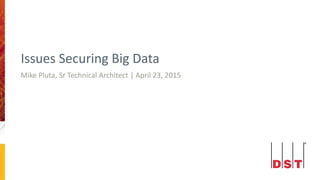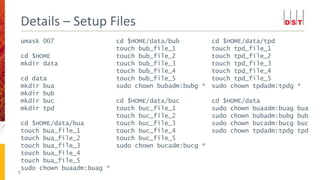Issues Securing (Big) Data
- 1. Issues Securing Big Data Mike Pluta, Sr Technical Architect | April 23, 2015
- 2. The enclosed materials are highly sensitive, proprietary and confidential. Please use every effort to safeguard the confidentiality of these materials. Please do not copy, distribute, use, share or otherwise provide access to these materials to any person inside or outside DST Systems, Inc. without prior written approval. This proprietary, confidential presentation is for general informational purposes only and does not constitute an agreement. By making this presentation available to you, we are not granting any express or implied rights or licenses under any intellectual property right. If we permit your printing, copying or transmitting of content in this presentation, it is under a non-exclusive, non-transferable, limited license, and you must include or refer to the copyright notice contained in this document. You may not create derivative works of this presentation or its content without our prior written permission. Any reference in this presentation to another entity or its products or services is provided for convenience only and does not constitute an offer to sell, or the solicitation of an offer to buy, any products or services offered by such entity, nor does such reference constitute our endorsement, referral, or recommendation. Our trademarks and service marks and those of third parties used in this presentation are the property of their respective owners. ┬® 2015 DST Systems, Inc. All rights reserved. DisclaimerDisclaimer
- 3. ŌĆó DST has established internal rules around the use of Big Data ŌĆó Data flowing into our data lake is partitioned by, what we call, Data Domains ŌĆó Each DST business unit is in essence at least one Data Domain ŌĆó Data Domains serve as the primary method of organizing our permission-ing Big (or not) Data Security
- 4. ŌĆó By default, one Business Unit is not granted access to anotherŌĆÖs data ŌĆó Agreements between business units are made to access data for purpose ŌĆó Internal Data Scientists are given cross-Business Unit access to data ŌĆó Management mandate to secure data which has not been explicitly granted access What This Means 4
- 5. ŌĆó These rules result in a very complex matrix of permissions ŌĆó Example below ŌĆó Data Doman ŌĆśBusiness Unit AŌĆÖ may be accessed by Business Unit A and Business Unit D. Business Units B and C may not access this Data Domain Complexity 5 BU A BU B BU C BU D DataDomain Business Unit A X X Business Unit B X X Business Unit C X X X Third Party Data X X
- 6. ŌĆó LetŌĆÖs deal with just text data on a file system in a Linux server ŌĆó Logical approach is to arrange directories to track with the Data Domains ŌĆó For permission-ing, create a group and directory for each Data Domain ŌĆó Assign the group ownership as appropriate ŌĆó Set umask to 007 ŌĆō new files to have u:rw-, g:rw-, o:--- permissions Scenario 6
- 7. sudo useradd buaadm sudo passwd -d buaadm sudo useradd bubadm sudo passwd -d bubadm sudo useradd bucadm sudo passwd -d bucadm sudo useradd budadm sudo passwd -d budadm sudo useradd tpdadm sudo passwd -d tpdadm Details ŌĆō Setup Users and Groups 7 sudo groupadd buag sudo usermod -G buag buaadm sudo groupadd bubg sudo usermod -G bubg bubadm sudo groupadd bucg sudo usermod -G bucg bucadm sudo groupadd budg sudo usermod -G budg budadm sudo groupadd tpdg sudo usermod -G tpdg tpdadm sudo usermod -a -G buag,bubg,bucg,budg,tpdg dt206031
- 8. umask 007 cd $HOME mkdir data cd data mkdir bua mkdir bub mkdir buc mkdir tpd cd $HOME/data/bua touch bua_file_1 touch bua_file_2 touch bua_file_3 touch bua_file_4 touch bua_file_5 sudo chown buaadm:buag * Details ŌĆō Setup Files 8 cd $HOME/data/bub touch bub_file_1 touch bub_file_2 touch bub_file_3 touch bub_file_4 touch bub_file_5 sudo chown bubadm:bubg * cd $HOME/data/buc touch buc_file_1 touch buc_file_2 touch buc_file_3 touch buc_file_4 touch buc_file_5 sudo chown bucadm:bucg * cd $HOME/data/tpd touch tpd_file_1 touch tpd_file_2 touch tpd_file_3 touch tpd_file_4 touch tpd_file_5 sudo chown tpdadm:tpdg * cd $HOME/data sudo chown buaadm:buag bua sudo chown bubadm:bubg bub sudo chown bucadm:bucg buc sudo chown tpdadm:tpdg tpd
- 9. What It Looks Like 9
- 10. ŌĆó The directory for the Data Domain ŌĆśBusiness Unit AŌĆÖ can be accessed by members of the ŌĆśbuaŌĆÖ group ŌĆó How can we grant additional access to the ŌĆśbudŌĆÖ group, but still restrict other groups? Complexity Redux 10 BU A BU B BU C BU D DataDomain Business Unit A X X Business Unit B X X Business Unit C X X X Third Party Data X X
- 11. ŌĆó POSIX Access Control Lists (ACLs) are the answer to our dilemma ŌĆó Not enabled by default. Needs to be enabled at the filesystem level ŌĆó mount with the remount and acl options can enable ŌĆó mount ŌĆōo remount ŌĆōo acl /dev/sda5 /home ŌĆó See your system administrator for the permanent enable The Secret Sauce 11
- 12. ŌĆó setfacl is used to set the ACL for a file or directory ŌĆó getfacl is used to query and list the ACL of a file or directory ŌĆó Our specific need: ŌĆó In addition to rwx permissions for the group ŌĆśbuagŌĆÖ, add rwx permissions for the group ŌĆśbudgŌĆÖ to the directory ŌĆśbuaŌĆÖ ŌĆó In addition to rwx permissions for the group ŌĆśbubgŌĆÖ, add rwx permissions for the group ŌĆśbudgŌĆÖ to the directory ŌĆśbubŌĆÖ ŌĆó In addition to rwx permissions for the group ŌĆśbucgŌĆÖ, add rwx permissions for the groups ŌĆśbubgŌĆÖ and ŌĆśbudgŌĆÖ to the directory ŌĆśbucŌĆÖ ŌĆó In addition to rwx permissions for the group ŌĆśtpdgŌĆÖ, add rwx permissions for the groups ŌĆśbucgŌĆÖ and ŌĆśbudgŌĆÖ to the directory ŌĆśtpdŌĆÖ The Tools 12
- 13. ŌĆó In addition to rwx permissions for the group ŌĆśbuagŌĆÖ, add rwx permissions for the group ŌĆśbudgŌĆÖ to the directory and contents of ŌĆśbuaŌĆÖ ŌĆó setfacl ŌĆōR --set u::rwx,g::rwx,o::-,g:budg:rwx bua ŌĆó In addition to rwx permissions for the group ŌĆśbubgŌĆÖ, add rwx permissions for the group ŌĆśbudgŌĆÖ to the directory and contents of ŌĆśbubŌĆÖ ŌĆó setfacl ŌĆōR --set u::rwx,g::rwx,o::-,g:budg:rwx bub ŌĆó In addition to rwx permissions for the group ŌĆśbucgŌĆÖ, add rwx permissions for the groups ŌĆśbubgŌĆÖ and ŌĆśbudgŌĆÖ to the directory and contents of ŌĆśbucŌĆÖ ŌĆó setfacl ŌĆōR --set u::rwx,g::rwx,o::-,g:bubg:rwx,g:budg:rwx buc ŌĆó In addition to rwx permissions for the group ŌĆśtpdgŌĆÖ, add rwx permissions for the groups ŌĆśbucgŌĆÖ and ŌĆśbudgŌĆÖ to the directory and contents of ŌĆśtpdŌĆÖ ŌĆó setfacl ŌĆōR --set u::rwx,g::rwx,o::-,g:bucg:rwx,g:budg:rwx tpd The Commands 13
- 14. Results 14
- 15. ŌĆó Hadoop HDFS v2.6 adds POSIX ACLs ŌĆó Make sure to turn it on first hdfs-site.xml <property> <name>dfs.namenode.acls.enabled</name> <value>true</value> </property> ŌĆó Reboot the namenode ŌĆó Set an ACL hdfs dfs -setfacl -m u::rwx,g::rwx,o::-,g:budg:rwx /bua ŌĆó See the ACLs hdfs dfs ŌĆōgetfacl /bua How To Hadoop It 15
- 16. ŌĆó Use a Default ACL for Automatic Application to New Children sudo setfacl -d --set u::rwx,g::rwx,o::-,g:budg:rwx bua sudo setfacl -d --set u::rwx,g::rwx,o::-,g:budg:rwx bub sudo setfacl -d --set u::rwx,g::rwx,o::-,g:bubg:rwx,g:budg:rwx buc sudo setfacl -d --set u::rwx,g::rwx,o::-,g:bucg:rwx,g:budg:rwx tpd ŌĆó And in HadoopŌĆ” hadoop fs -setfacl --set d:u::rwx,d:g::rwx,d:o::-,d:g:budg:rwx bua hadoop fs -setfacl --set d:u::rwx,d:g::rwx,d:o::-,d:g:budg:rwx bub hadoop fs -setfacl --set d:u::rwx,d:g::rwx,d:o::-,d:g:bubg:rwx,d:g:budg:rwx buc hadoop fs -setfacl --set d:u::rwx,d:g::rwx,d:o::-,d:g:bucg:rwx,d:g:budg:rwx tpd Other Goodies 16
- 17. Results With Default ACLs 17
- 18. ŌĆó DonŌĆÖt forget about the sticky bit ŌĆó Makes it so that only root or the directory owner can delete files sudo chmod +t bua ŌĆó Use the setgid bit to set new files in a directory to have the same group owner as the directory. ŌĆó Very handy when paired with default ACLS sudo chmod g+s bua Last Extra Bits 18
- 19. 19



















